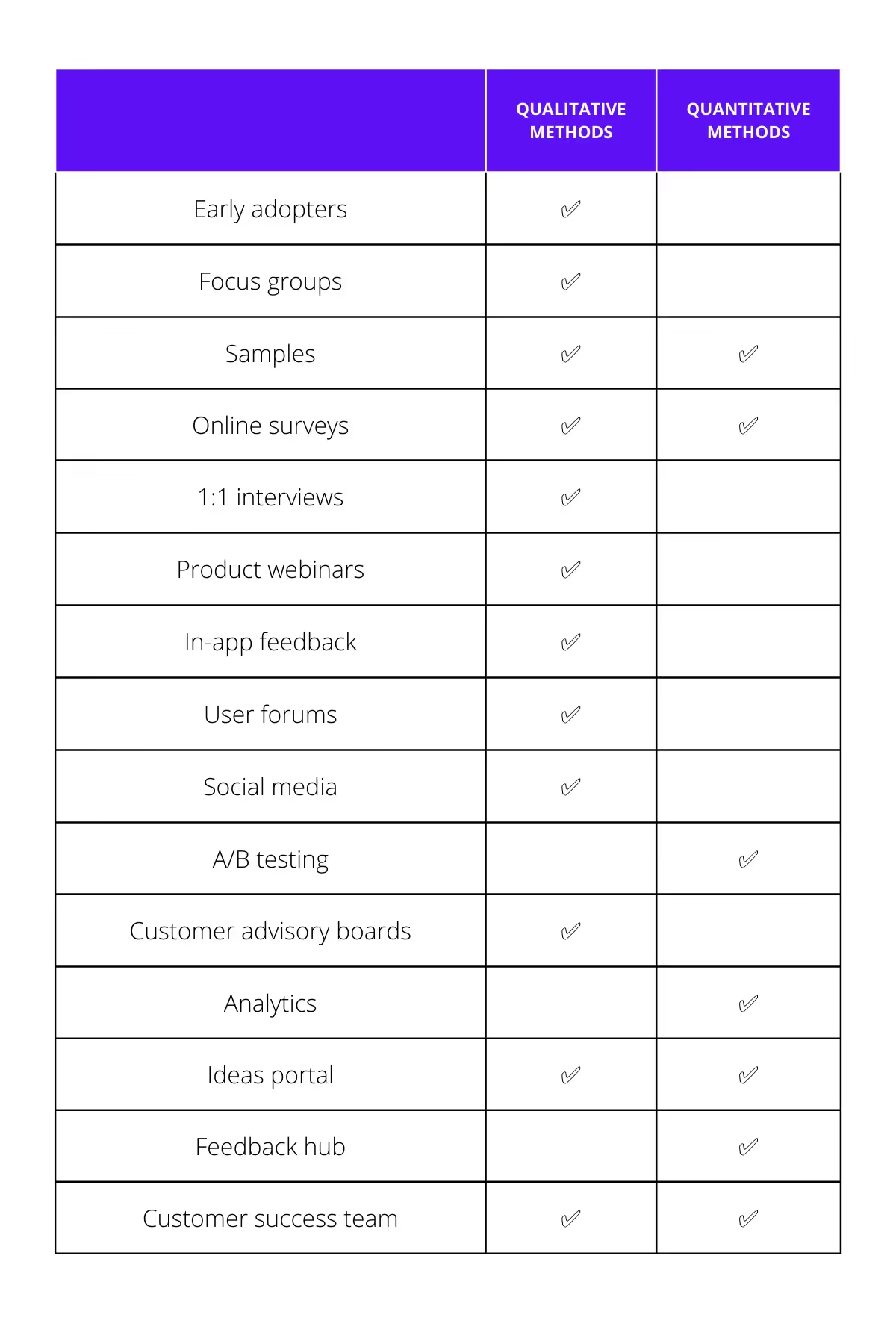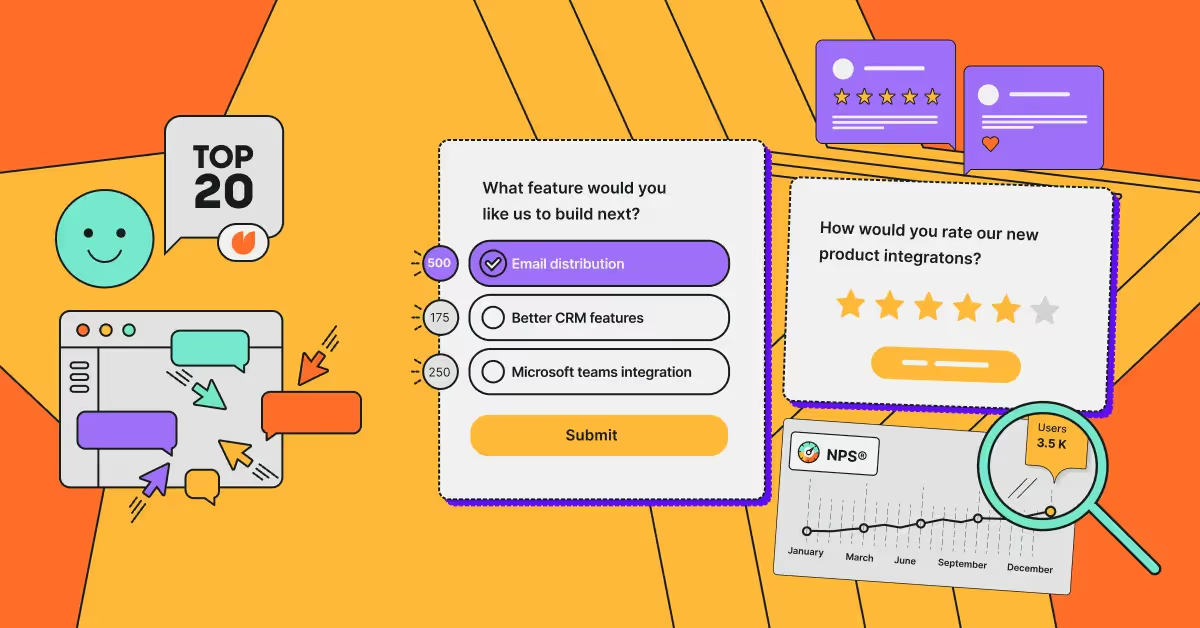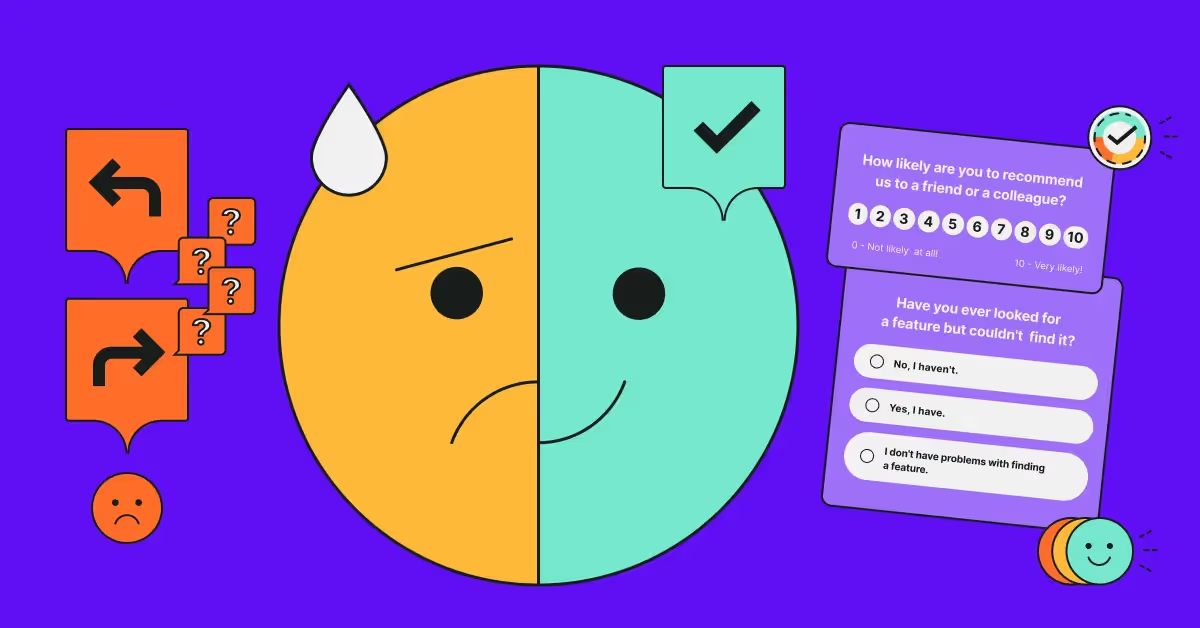A lot goes into creating a product – from product research, design, to making sure it works well to getting it into customers' hands. But how do you know if your product is any good?
It can be tough to tell, especially if you're too close to the project.
And here is where customers' words can give you unbiased insight. Gaining it, however, can be fairly challenging.
Listed below are a few ways to launch immediately to get feedback from customers about your product.

What is product feedback?
Product feedback is the process of collecting information and opinions about a product from customers and other users.
It's a compilation of the perspectives, experiences, and frustrations of people who work (or used to work) with a product.
Product feedback aims to understand how well the product is performing and identify areas for improving customer experience with the product. It can be used to optimize, for example, the product design and usability or to assess customer satisfaction. It's a way of making sure that what you're doing is actually working and solving customers’ pain points.
Ultimately, product feedback is a process in which information about the output of a system is used to modify the next input to create a better product continually (the so-called feedback loop).
A good product feedback collection process works like a lighthouse that helps you find the way to your goal.
The challenges of collecting product feedback
As social networks and digital marketing methods evolve, customers' voices become increasingly influential. Nearly all consumers (95%) read reviews, and 86% consider them an essential resource when making purchase decisions.
It puts a lot of pressure on businesses to deliver great products and services, as even one negative experience can quickly become public knowledge.
It's no wonder, then, that product feedback has become such an essential part of the development process. However, collecting customer feedback can be a challenge in itself.
Challenge #1: Getting people to leave feedback
With so many demands on time, it's easy to understand why customers might not want to take the time to provide feedback.
Thus, businesses must find ways to make it as easy and convenient as possible for customers to leave their opinions. One way to do this is by offering incentives, such as discounts or coupons. Another is simply asking customers for feedback at strategic moments, such as after purchasing or using a product.
Challenge #2: Reluctance to express opinions
Customers are often reluctant to provide honest customer feedback, fearing it may reflect poorly on them or the company. There could be several reasons for this: perhaps they had a negative experience and didn't want to relive it, or maybe they don't think their opinion will make a difference.
Instead, they tend to either remain silent or give vague compliments that don't offer much constructive criticism. To deal with it, you need to create an environment where customers feel comfortable giving honest feedback.
Challenge #3: Running out of ideas
When you've been working on a product for a long time, it can be challenging to see it from the customer's perspective. As a result, you may start to run out of ideas for how to improve it.
Also, you might struggle with how to gather the necessary information from your customers. Despite doing all you can, are you still having difficulty getting your customers to leave a review? The next part of the article will benefit you in this situation.
Let's see how to ask for feedback to get your desired results.
How to collect more feedback: 10+ methods
In any business, gathering high-quality feedback and information should be a continuous structured process to keep new ideas flowing. The following are some of the ways that product managers use for receiving feedback.
01 Ask early adopters
By engaging with your beta testers, you can get genuine and honest feedback. Furthermore, these people are more likely to be excited about your product and its potential. Use that and ask for their opinions as early as possible in the development process.
02 Set up a focus group
It is a small, carefully selected group of people that are asked about their opinions and attitudes towards your product in front of a moderator. With the ability to dig deeper and ask follow-up questions, this approach can provide fairly detailed findings.
Note: Diversifying the focus group allows for unbiased results.
03 Send samples
Sending product samples to individuals or even companies in your target market is an excellent way to get input. The people that receive the samples can test them out and see if it is a good fit for them – and if so, lead to further action.
04 Create an online survey
One of the most common ways to gather customer feedback is through customer feedback surveys. By creating a well-crafted feedback form, you can collect a lot of data in a short amount of time (see it in action with Survicate). Take advantage of Survicate and create such surveys as:
Want to make survey creation even easier? Take advantage of many product feedback survey templates available.
05 Perform 1:1 interviews
An individual interview is an excellent opportunity to get in-depth feedback from your users. It also allows you to build relationships and understand their needs better.
Note: Whether in person or over the phone, ask only the essential questions that will get you the answers you are looking for.
06 Run a product webinar with a Q&A session
You can use this method to speak about your product and answer any questions that your potential customers may have. Plus, product webinars are a great way to generate leads, as you can include a call-to-action at the end of the session.
07 Set up in-app feedback notifications
In-app feedback alerts are a superb way to get people to leave their thoughts and suggestions while using your product. Thanks to that, feedback is relevant and coming from active users. As well as that, alerts help you to stay on top of how users feel about the app experience you provide..
08 Get involved in user forums
Online communities are a great place to find out what people think about your product. You can also use them to answer users' questions and build a buzz around your product. As customers can answer each others’ questions, it can also reduce the number of queries coming your way (and improve customer service after all).
09 Use social media
In general, social media channels are a great way to connect with current and potential customers. If you actively monitor your channels, you can quickly answer any questions or address any concerns that come up. In addition, you can use social media to gauge sentiment around your product.
10 Put A/B testing in place
A/B testing is a great way to see how different changes impact the user experience. For example, you can test two versions of the same landing page and see which one performs better. By running tests, you can make data-driven decisions on which version of your product to go with.
Note: A/B testing can be used to gain insight during beta testing or even on launch day.
11 Create Customer Advisory Boards
A customer advisory board is a group of existing customers who meet regularly to give feedback. They can provide valuable feedback and influence your product's future direction. Usually, these people are experts with solid knowledge and track trends and the market to share strategic recommendations.
12 Monitor the situation with analytics
Product analytics tools allow product developers and people involved to see the exact path users take while using your product. This data help to analyze user behavior – what causes customers to get stuck and what areas need immediate improvement. As a result, you will be able to prioritize your development efforts.
13 Think about an ideas portal
This is a platform where users can submit suggestions for improvements, new features, or anything else they think would be helpful. This method will let you hear directly from your users about what they think and adjust the changes accordingly. It gives you a clear idea of what's most important to your users.
14 Create a feedback hub
A feedback hub is a central place where you can collect customer feedback about your product. It streamlines the workflow a lot–you can connect multiple feedback sources and manage them more efficiently. Survicate's Insights Hub automatically categorizes the feedback with AI, and the additional Research Assistant answers all questions related to the feedback you've gathered in a chat conversation.

15 Collaborate with the customer success team
The customer success team is the one that has constant contact with your customers and has a wealth of knowledge about their needs and wants. Make use of their knowledge – they might be able to notice things that you've missed.
Table: Qualitative vs Quantitative product feedback methods

Getting product feedback from your customers vs potential customers
You wonder whether you should reach out to your current customers or potential new ones when collecting customer feedback. After all, both groups have different perspectives.
Current customers
- You already have a relationship with them, so they're more likely to trust you and give you honest feedback.
- They've already bought your product, so they have first-hand experience with it.
- They may be biased in their feedback, either because they're already invested in the product or because they had a bad experience.
- You may only get feedback from customers who are disappointed with the product, as those who are satisfied may not see the need to provide feedback.
Potential customers
- They're more likely to be objective in their feedback, as they don't have the same emotional (and financial) investment in the product.
- You can get customer feedback from people at different stages of the buyer's journey, so you can see how your product performs at each stage.
- You may have to work a bit harder to build trust with potential customers, as they don't know you yet.
- You may only be able to get customer feedback from a small number of people, as it can be difficult to find potential customers who are willing to provide feedback.
So, which should you choose? Ultimately, the best approach is to try and get feedback from both groups. Through this, you can get a more well-rounded view of your product and how it's performing.
How to act on the feedback you receive
Even when you find out how to get feedback, the process does not end there – you also need to know how to deal with it properly.
So don't just leave your customers' ideas at the door when they come in – use them to make something great happen for all involved.
Close the feedback loop
It's important to let your customers know that you've received their feedback and are taking it into account. It shows that you're listening to them and value their input. You can do this by sending a follow-up email, giving them a call, or responding to their review. Thank them for their time and effort.
Stay updated
To know what it's going on with your product constantly, you need to have a good feedback tool. It will help you keep track of all the feedback you receive and ensure that nothing falls through the cracks. If you use Survicate, don't forget to set up email notifications and Slack alerts to act on feedback immediately.
Come up with a plan
Making the most of feedback requires a plan of action and good organization. Start by categorizing the feedback – to see what the main issues are. Then, prioritize the input and focus on the areas that will significantly impact your product. Finally, don't forget to create a timeline for implementing changes.
➡️ See how Survicate can help you act on the feedback you receive
Become a product feedback expert
Product feedback should have no more secrets from you now. You know the customer feedback methods to get it and how to make the most of it.
All that's left is to put this knowledge into practice. Why not with Survicate. Start with a no-strings-attached free 10-day trial of the Best plan, with all features unlocked so you can experience effortless survey creation and workflow building in no time. Try now!













.avif)
.avif)


